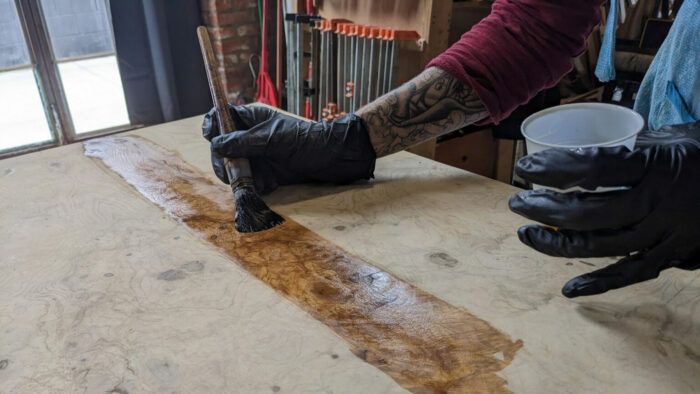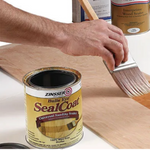Two ingredients for added durability in shellac
Finishing is kind of like playing ball in the house. Can you fix it when you throw too hard?
What is my favorite finish?
There are thousands of finishes out there and each one will have strengths and weaknesses. In restoration and conservation, we see so many finishes fail. The things I look for most out of a finish are threefold. Durability: Can I throw things at it? Repairability: Can I fix it when I throw too hard? And reversibility: Can I undo it?
I prefer shellac over almost all finishes because it fits all of those parameters. I got my start in woodworking in a one-size-fits-all spray lacquer refinishing shop. After three years, I understood that one size does not fit all. The toxicity and danger of removing and reapplying plasticky lacquers led to me realize I prefer shellac one hundred times over. It fits all my parameters. It is repairable, reversible, and does not look like plastic.

What is shellac?
Shellac is a natural resin, a complex mixture of polymers that is used widely even outside of woodworking. The resin is cleaned and filtered of impurities and returned to a dry crystalline form, hence the variety in weights and colors. The cultivation of shellac resins is intrinsically linked with humanity, a resource with history that includes threatened systems of indigenous knowledge and wisdom. Properly cared for, shellac lasts an exceedingly long time.
How can I supply shellac with heat resistance?
But here’s how I like to tweak it to last even longer. I combine recommendations from conservation literature on wooden artifacts and add two materials, one for heat and one for UV-damage. Heat frequently bubbles a finish and the sun degrades the wood, sometimes slowly, sometimes quickly. Laropal A-81 belongs to a class of resins with excellent heat resistance and durability. Tinuvin 292 belongs to a class of light stabilizers, commonly called UV-absorbers, with excellent resistance to harm caused by light and oxidation. They protect both the finish and the wood, where oxidation does damage to both. Refer to these pictures for a table that with very little protection from a failed finish, where the wood started fall apart.

Does it stand the test of time?
Both Laropal A81 and Tinuvin 292 can be added to a wide variety of finishes. Acrylics, alkyds, vinyls, and of course shellacs, are all commonly modified with Laropal and Tinuvin to increase their lifetime. They slow the rate of oxidation in the finish and prevent harmful wavelengths of light from reaching the wood below. For me, this is important for the integrity of the wood in general, but especially those with highly figured woods I’d like to preserve the aesthetic qualities of.
This shellac cocktail mixture is both easy to spray or apply by hand. My mentor, Chris Bame, uses my first test table as his dining table. He maintains it receives regular abuse of spilled coffee and hot pans straight out-of-the-oven to assess the damage. News flash: It’s doing great.
The ratios of the shellac, Tinuvin and Laropal, can even be tweaked depending on your level of comfort. It can be dulled to a flat matte or polished to a high gloss. Shellac is your challenge, should you choose to accept it.
A quick ratio to try yourself
500 g Ethanol
70g Shellac
30g Laropal A81
1g Tinuvin 292
 |
Finishing issues in woodworkingYour shop and your high school chemistry class are more alike than you’d think. |
 |
Torture test for outdoor finishes: The endMother Nature: 1, outdoor finishes: 0. |
 |
10 Best Fixes for Finishing Mistakes |
Fine Woodworking Recommended Products

Bumblechutes Bee’Nooba Wax

Foam Brushes
























Comments
Great argument for shellac. Great trade secrets. Thank. you!
Goodness, this is rich! But, WUH? I’ve been reading FWW for close to 40 years and never before noticed a reference to these 2 additives??!! Thank you for this (now bookmarked) post.
The article should note that Tinuvin 292 is a very strong Skin sensitization, hazard category 1 (1 out of 5) and a "Reproductive toxicity, hazard category 2" (2 out of 5 with 5 lowest).
Whereas Laropal A 81 appears similar to other workshop chemicals.
Also the green bottles of denatured alcohol (ethanol) is considerably safer than the mostly methanol (wood alcohol) used in standard denatured alcohol. The green bottles use acetone, isopropanol, or ethyl acetate to denature. These are considerably less hazardous.
And I agree with using shellac for a finish. A modified french polish method produces fantastic looks. But make sure absolutely no oils or waxes are on the surface, including natural wood oils.
I recall using Tinuvin P-something, years ago in some of our products. I always assumed it worked as we never had UV fading complaints.
Just ordered some of each. Gonna give this a try.
Would like to see more articles like this.
Love this! Never heard of these chemicals and going to get some now. Always loved working with shellac as I mainly do finishing. So many different things you can do with it. Especially love it on gun stocks and knife handles. Sanded back to just fill grain and then polished with a plastic polish. Never thought of using it on table tops though.
Log in or create an account to post a comment.
Sign up Log in